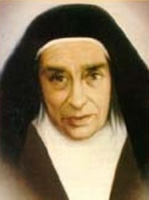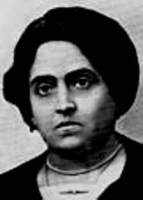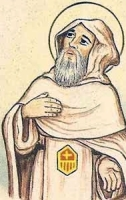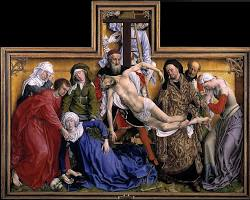Pope Saint Damasus I
தூய தமசுஸ்
அன்னையாம் திரு அவை இன்று தூய தமசுஸின் நினைவுநாளைக் கொண்டாடி மகிழ்கின்றது. இவர் 304 ஆம் ஆண்டு, உரோமை நகரில் பிறந்திருக்கலாம் என்று நம்பப்படுகின்றது.
இவர் உரோமை நகரில் இருந்த மறைசாட்சியான தூய லாரன்சின் ஆலயத்தில் திருத்தொண்டராக தன்னுடைய பணிவாழ்வைத் தொடங்கினார். இதற்குப் பின்பு திருத்தந்தை தூய லிபேரியுஸ் என்பவரிடத்தில் செயலராகப் பணியாற்றினார். 366 ஆம் ஆண்டு, திருத்தந்தை இறந்துவிட, தமசுஸ் திருத்தந்தையாகத் தேர்ந்தெடுக்கப்பட்டார். ஆனால் தமசுஸ் திருத்தந்தையாக தேர்ந்தெடுக்கப்பட்டது, திருத்தொண்டராக இருந்த உர்சினியுஸ் என்பவருக்குப் பிடிக்கவில்லை. உர்சினியுஸ் தன்னோடு ஒருசில ஆட்களைச் சேர்த்துக்கொண்டு, தன்னை திருத்தந்தையாக அறிவித்துக்கொண்டார். இதனால் திருச்சபையில் பெரிய குழப்பம் ஏற்பட்டது.
இதனை அறிந்த வலேண்டின் அரசர் தமசுஸ்தான் முறைப்படி தேர்ந்தெடுக்கப்பட்ட திருத்தந்தை என்று சொல்லி, அவரைத் திருத்தந்தையாக அங்கிகரித்தார். இவருக்கு முட்டுக்கட்டை போட்டுக்கொண்டிருந்த உர்சினியுசை அவர் நாடு நாடுகடத்தினார். என்னதான் உர்சினியுஸ் உரோமையிலிருந்து வெளியேற்றப்பட்டாலும், அவருடைய ஆதரவாளர்கள் திருத்தந்தை தமசுசின் பெயரைக் கெடுப்பதும், அவருக்கு முட்டுக்கட்டை போடுவதுமாக இருந்தார்கள். இதற்கு ஒரு முடிவுகட்ட விரும்பிய திருத்தந்தை 380 ஆம் ஆண்டு ஆயர்கள் கூட்டத்தைக் கூட்டி அவர்களை ஒன்றுமில்லாமல் செய்தார்.
இப்படி தமசுஸ் திருத்தந்தையாக பொறுப்பேற்ற புதிதில் பல்வேறு பிரச்சனைகளைச் சந்தித்தாலும், நாட்கள் செல்லச் செல்ல பல்வேறு பணிகளை மிகத் திறம்பட செய்யத் தொடங்கினார். 380 ஆம் ஆண்டு, உரோமையை ஆண்டுவந்த தியோடோசியுஸ் என்ற மன்னர் கிறிஸ்தவ மதத்தை அரசாங்க மதமாக அறிவித்தார். இதனால் கிறிஸ்தவ மதத்திற்கு எதிராக விதிக்கப்பட்ட எல்லாத் தடைகளும் நீங்கின. இதைத் தொடர்ந்து திருத்தந்தை தமசுஸ், கான்ஸ்டான்டிநோபில் என்ற பொதுச்சங்கத்தைக் கூட்டினார். இச்சங்கம் ஆரியபதத்தையும், தூய ஆவியாரை இறைவன் இல்லை என்று சொல்லிவந்த மாசிதோனிய தப்பறைக் கொள்கையினையும் முற்றிலுமே எதிர்த்து நிர்முலமாக்கியது.
இது மட்டுமல்லாமல் உரோமையரின் ஆட்சியில், விவிலியம் தொடர்பாக எழுதப்பட்டவை யாவும் வெளிக்கொண்டு வராமலே இருந்தன. இப்போது கிறிஸ்தவ மதத்திற்கு எதிரான தடைகள் நீங்கியதால், திருத்தந்தை தமசுஸ் அவற்றை எல்லாம் வெளிக்கொண்டு வர பெரிதும் உழைத்தார். இவருடைய காலத்தில்தான் தூய ஜெரோம் விவிலியத்தை லத்தின் மொழிக்கு மொழிபெயர்த்த முக்கியான ஒரு நிகழ்வு அரங்கேறியது. மேலும் இவர் தனக்கு முன்பாக இருந்த திருத்தந்தையர்களின் பட்டியலைத் தயார் அதை வெளியிட்டார். இவை எல்லாவற்றுக்கும் மேலாக உரோமானிய கல்லறைகளை எல்லாம் புனிதத்தலமாக மாற்றி, அதனை மக்களுடைய பார்வைக்கு வைத்தார். இதுபோன்று பல்வேறு பணிகள் திருத்தந்தை தமசுஸின் காலத்தில் நடைபெற்றன.
இப்படி திரு அவையின் வளர்ச்சிக்காக அயராது பாடுபட்டு உழைத்த திருத்தந்தை தமசுஸ் 384 ஆம் ஆண்டு இறையடி சேர்ந்தார்.
Profile
Raised in a pious family; his father was a priest in Rome, Italy and Damasus served for a time as deacon in his father's church, Saint Laurence. Priest. Assistant to Pope Liberius. Chosen 37th pope in a disputed election in which a minority chose the anti-pope Ursinus. The two reigned simultaneously in Rome which eventually led to violence between their supporters and false accusations of Damasus having committed a crime.
His pontificate suffered from the rise of Arianism, and from several schisms including break-away groups in Antioch, Constantinople, Sardinia, and Rome. However, it was during Damasus's reign that Christianity was declared the religion of the Roman state. He enforced the 370 edict of Emperor Valentinian controlling gifts to prelates, and opposed Arianism and Apollinarianism. He supported the 374 council of Rome which decreed the valid books of the Bible, and the Grand Council of Constantinople in 381 which condemned Arianism.
Economic patron of his secretary, Saint Jerome, commissioning him to make the translation of scripture now known as the Vulgate. Damasus restored catacombs, shrines, and the tombs of martyrs, and wrote poetry and metrical inscriptions about and dedicated to martyrs. They state that he would like to be buried in the catacombs with the early martyrs, but that the presence of one of his lowly status would profane such an august place. Ten of his letters, personal and pontifical, have survived.
Born
• c.306 in Rome, Italy
• his family were Spanish in orgin
Papal Ascension
366
Died
• 11 December 384 in Rome, Italy of natural causes
• buried in the Mark and Marcellianus catacombs in Rome
• bones re-buried in the church of San Lorenzo in Damaso
Saint María Maravillas de Jesús
Also known as
• Maravillas Pidal y Chico de Guzmán
• Maria de las Maravillas Jesus
Profile
Daughter of Luis Pidal y Mon and Cristina Chico de Guzman y Munoz, the Marquess and Marchioness of Pidal; her father was Spanish ambassador to the Vatican and a very active supporter of the Church. She was baptized at the age of eight days, Confirmed in 1896, made her first Communion in 1902, grew up in a pious family, was known as an intelligent and religious child, and early perceived a call to religious life. She entered the Carmelite novitiate at El Escorial, Madrid, Spain in 1920.
On 19 May 1924 Maria and three sisters founded a house at Cerro de los Angeles, Madrid, the geographical center of Spain, and she took her final vows there on 30 May 1924. Prioress of the house in 1926. The house expanded so quickly that Mother Marvillas was sent to found another in Kottayam, India, which over the years has expanded to many other Carmels in that country. She returned to Spain, and in 1936, as part of the anti-clerical actions of the Spanish Civil War, she and her sisters were arrested, relocated to Madrid, and subjected to fourteen months of house arrest and harassment. In September 1937 Mother Maravillas and her community relocated to las Batuecas, Salamanca, Spain where they founded a new house.
In 1939 she led a group of sisters to restore the house at Cerro de los Angeles. From there she led an expansion of the Carmelites with houses in Mancera de Abajo, Salamanca in 1944, Duruelo, Avíla in 1947, Cabrera, Salamanca 1950, Arenas de San Pedro, Avíla in 1954, San Calixto, Córdoba in 1956, Aravaca, Madrid in 1958, Talavera de la Reina, Toledo c.1960, la Aldeheula, Madrid in 1961, and Montemar-Torremolinos, Málaga in 1964. To unite these and other far-flung houses, she founded the Association of Saint Teresa in 1972. The Carmel in la Aldeheula was hugely expanded with schools, a community of houses for the local poor, church, community halls and other structures in what effectively became a small town.
In all these works Mother Maravillas was known for her dedication for work and prayer, her humility and care of her younger sisters, and her dedication to the Rules and spirituality of the Discalced Carmelites.
Born
4 November 1891 in Madrid, Spain
Died
11 December 1974 in La Aldehuela monastery, Madrid province, Spain of natural causes
Canonized
4 May 2003 by Pope John Paul II
Blessed Arthur Bell
Also known as
Francis Bell
Additional Memorial
22 November as one of the Martyrs of England, Scotland, and Wales
Profile
Studied at Saint Omer and at the Royal College of Saint Alban, Valladolid, Spain. Ordained in Salamanca, Spain in 1618. Joined the Franciscans in 1618. Worked in Douai and Gravelines in France, and Brussels, Belgium. He returned to England to minister to covert Catholics in 1634. Arrested and condemned to death for the crime of being a priest. Martyr.
Born
13 January 1590 in Temple Broughton, Worcestershire, England
Died
hanged, drawn, and quartered on 11 December 1643 at Tyburn, London, England
Beatified
22 November 1987 by Pope John Paul II
Saint Daniel the Stylite
Also known as
Daniel of Constantinople
Profile
Monk at Samosata on the Upper Euphrates River at the age of twelve. When chosen abbot by his brothers, he declined. He made two trips to learn from Saint Simeon Stylites the Elder, and received that saint's blessing. Would-be pilgrim to the Holy Lands, but a vision of Saint Simeon caused him to travel instead to Constantinople where he spent the rest of his life. At age 42, Daniel decided to become a pillar-dwelling hermit like Simeon, and spent the next thirty-three years on one.
Daniel lived on a series of pillars built for him by Emperor Leo I and other wealthy supporters, living in the open weather, standing each day until he collapsed. Ordained by Saint Gennadius. Many came to learn from the holy man, sitting at the foot of the pillar as he preached, celebrated Mass, gave spiritual counsel, and healed the sick who were taken up to his platform. Counsellor to Emperor Leo, Emperor Zeno, and the Patriarch of Constantinople; prophesied some of the political turmoil in which Zeno was involved. Daniel came down from his pillar only once - to convince Emperor Baliscus to abandon the Monophysite heresy.
Born
409 at Maratha, Syria
Died
• 493 near Constantinople of natural causes
• accurately predicted the date of his death, and near the end he had visions of angels
Saint Masona of Mérida
Also known as
Mausona
Additional Memorial
14 November as one of the Holy Fathers of Mérida
Profile
Born to the Gothic nobility, Masona was educated at the monastery affiliated with the Basilica of Saint Eulalia in Mérida, Spain. He was known as an excellent and pious student, and when he was old enough, entered the monastery. Chosen bishop of Mérida c.572. He built a hospital, staffed it with doctors and nurses, supported the work and expansion of churches and monasteries in the region, and was noted for his almsgiving to help the poor. He participated in the 3rd Council of Toledo in 589, which led to the conversion of the Visigoths to Catholicism, the Synod of Toledo in 597, and he helped bring Saint Hermenegild to the faith. In the persecutions of Catholics by the Arian king Leovigildo, Masona was exiled for a time. Late in life he tried to put some of the administrative duties onto archdeacon Eleuterio, but Eleuterio was swayed those seeking power over the diocese, and Masona returned to full-time work until his death. Saint Gregory of Tours wrote about him, Saint Isidore of Seville wrote to him.
Died
c.606 in Mérida, Spain of natural causes
Blessed David of Himmerod
Profile
Studied in Paris, France. Benedictine Cistercian monk at Clairvaux Abbey in 1131; spiritual student of Saint Bernard of Clairvaux who accepted David after he had been initially rejected due to health problems. Assigned by Saint Bernard to found and lead the Himmerod Abbey, Trier, Germany in 1134. Miracle worker, healer, exorcist with the gift of prophecy.
Born
c.1100 in Florence, Italy
Died
• 11 December 1179 of natural causes
• buried in the chapter room of Himmerod Abbey
• relics transferred to a marble urn at the altar of the abbey church in 1204
• relics transferred to Trier, Germany in 1802 when the abbey was suppressed
• relics transferred back to the Himmerod Abbey in 1919 when the Cistercians returned to the house
Beatified
• in 1699 the general chapter of the monks of Citeaux authorized a memorial at Himmerod Abbey
• in 1734 the canon of Florence, Italy published a Life of David and obtained approval from Pope Clement XII to expose the relics for veneration
Blessed Franco of Siena
Blessed Franco of Siena
அருளாளர்_பிராங்கோ (-1291)
டிசம்பர் 11
இவர் (#BlFrancoOfSienna) இத்தாலியில் உள்ள சியன்னாவில் பிறந்தவர்.
இராணுவத்தில் பணிபுரிந்து வந்த இவர், சர்தியனோ என்ற இடத்தில் இருந்தபொழுது பார்வை இழந்தார். அப்பொழுது இவர் கடவுளிடம் "நான் மீண்டுமாகப் பார்வை பெற்றால், உம்முடைய பணியைச் செய்ய என்னுடைய வாழ்வை அர்ப்பணிப்பேன்" என்று வேண்டினார்.
இவர் வேண்டியது போன்றே, மீண்டுமாகப் பார்வை பெற்றார். இதன்பிறகு இவர் புனித நாடுகளுக்குத் திருப்பயணம் மேற்கொண்டார். சியன்னா நகரை இவர் அடைந்தபோது, அங்கே அருளாளர் அம்புரோஸ் போதித்துக் கொண்டிருந்தார். அவரது போதனையைக் கேட்ட இவர், துறவியாக வாழ முடிவு செய்து, இறைவேண்டலுக்கும், ஒறுத்தல் முயற்சிகளுக்கும் மிகுந்த முக்கியத்துவம் கொடுத்து வாழ்ந்து வந்தார்.
இவருக்கு இயேசுவும் புனித கன்னிமரியாவும் அடிக்கடி காட்சி கொடுத்தனர்.
இவ்வாறு இறைப்பணிக்காகத் தன்னை அர்ப்பணித்த இவர், 1291 ஆம் ஆண்டு இறையடி சேர்ந்தார்.
Also known as
Francesco Lippi
Profile
Born to the Italian nobility. Spent a dissolute youth as a soldier in Italy. Near Sartiano, Italy he was blinded, and offered to change his life if he was healed; he was healed. Pilgrim to Rome, Bari and Loreto in Italy. Having heard the preaching of Blessed Ambrose Sansedoni in Siena, Italy, he was moved to retire from the world to live as a hermit and do penance for his earlier life. Joined the Carmelites, but continued to live as a hermit. Received visions of Jesus, Mary and the angels; had the gift of prophecy, and was beset by demons.
Born
13th century Grottoes-Siena, Italy as Francesco Lippi
Died
• 11 December 1291 in Siena, Italy of natural causes
• some relics enshrined in the Carmelite monastery in Cremona, Italy
Beatified
1670 by Pope Clement X (cultus confirmation)
Blessed Jerome Ranuzzi
Also known as
• Jerome Ranucci
• Angel of Good Counsel
Profile
Born to a noted middle class family; his father was later given rank in the noblity. Servite. Studied philosophy and theology in Bologna, Italy. Priest. Renowned for his learning and scholarship. Advisor to Duke Frederick of Montefeltro, Urbino, Italy.
Born
c.1410 at Sant'Angelo, Vado, Pesaro-Urbino, Italy
Died
c.1468 of natural causes
Beatified
1 April 1775 by Pope Pius VI (cultus confirmed)
Blessed Severin Ott
Also known as
• Severinus
• Mariophylus Severinus
• Mariae servus Singularis
Profile
Norbertine canon of the monastery in Roggenburg, Swabia, Bavaria (in modern Germany). He was known for his deep prayer life, his personal penances, and his devotion to the Virgin Mary. Promoted pilgrimages to a shrine in nearby Sheissen. In his later years he withdrew to life as a prayerful hermit in a cell in the monastery, spending his life in prayer, spiritual communion and celebrating Mass alone.
Born
1627 in Germany
Died
noon 11 December 1708 of natural causes
Blessed Jean Laurens
Profile
Norbertine canon of the Averbode monastery near Diest, Brabant (in modern Belgium). Ordained in 1574. Sub-prior of his house and master of novices, he was known for instilling a zeal for the faith in his charges by his pious personal example. Vicar of Hechtel, Limburg, Belgium in 1586 when he was imprisoned by Protestants at war with the Church.
Born
1548 in Miskom, Kortenaken, Vlaams, Brabant, Flanders (in modern Belgium)
Died
11 December 1613 of natural causes
Blessed Pilar Villalonga Villalba
Profile
Lay woman in the archdiocese of Valencia, Spain. Member of Catholic Action. Martyred in the Spanish Civil War.
Born
22 January 1891 in Valencia, Spain
Died
11 December 1936 in Burjassot, Valencia, Spain
Beatified
11 March 2001 by Pope John Paul II
Saint Sabinus of Piacenza
Profile
Bishop of Piacenza, Italy. Friend of Saint Ambrose of Milan, he regularly read and commented on the first draft of Ambrose's writings. Dispatched by Pope Saint Damasus I to Antioch to suppress the Meletian Schism. Attended the Council of Aquileia in 381.
Died
420 of natural causes
Blessed Hugolinus Magalotti
Also known as
• Hugolino Magalotti
• Ugolino Magalotti
Profile
Friar Minor tertiary. Hermit.
Born
at Camerino, Italy
Died
11 December 1373 of natural causes
Beatified
4 December 1856 by Pope Pius IX (cultus confirmed)
Saint Cian of Wales
Profile
Sixth century soldier. Hermit in Wales. Servant to Saint Peris.
Profile:
Dates: Sixth century
Occupation: Soldier, Hermit, Servant to Saint Peris
Location: Wales
Feast Day: December 11th
Biography:
Saint Cian was a soldier who renounced his warlike ways and became a servant to Saint Peris, a missionary in Wales. After Peris's death, Cian lived as a hermit in Caernarfonshire.
Born
Welsh
Blessed Martín Lumbreras Peralta
Also known as
Father Martín of Saint Nicholas
Profile
Augustinian Recollect priest. Martyr.
Born
8 December 1598 in Zaragoza, Spain
Died
burned alive on 11 December 1632 in Nagasaki, Japan
Beatified
23 April 1989 by Pope John Paul II
Blessed Melchor Sánchez Pérez
Also known as
Father Melchor of Saint Augustine
Profile
Augustinian Recollect priest. Martyr.
Born
1599 in Granada, Spain
Died
burned alive on 11 December 1632 in Nagasaki, Japan
Beatified
23 April 1989 by Pope John Paul II
Saint Pens
Also known as
Peris
Profile
A cairn on the top of the Llanberis Pass in Wales is known as Corffwysfa Pens (the Resting-Place of Saint Pens), and there are traditions of pilgrimage to the hill to pray for the intercession of Saint Pens. However, no information about him has survived.
Patronage
Llanberis, Wales
Blessed Martino de Melgar
Profile
Commander of the Mercedarian convent of Santa Maria in Burgos, Spain. Noted for his personal piety and his support of the spiritual growth of the friars in his house.
Saint Aithalas of Arbela
Also known as
Aithelas
Profile
Pagan priest who was healed from a serious disease by the prayers of Christians; convert. Martyred in the persecutions of Shapur II.
Died
c.354 in Arbela, Persia
Saint Eutychius the Martyr
Also known as
• Eutychius of Spain
• Eutychius of Cadiz
• Eutuchius of Merida
• Oye
Profile
Martyr.
Died
4th century Spain
Saint Barsabas
Also known as
Barsabbas
Profile
Abbot. Known as a miracle worker. Martyred with twelve of his monks in the persecutions of the Sassanid King Shapur II.
Born
Persian
Died
martyred in 342
Saint Fidweten
Also known as
Fivetein, Fidivitanus
Profile
Benedictine monk at Saint Saviour Abbey in Redon, Brittany (in modern France). Spiritual student of Saint Convoyon of Redon.
Died
c.888 of natural causes
Blessed Dominic Yanez
Profile
Blessed Dominic Yáñez (1572-1647) was a Spanish Dominican priest known for his work with the poor and marginalized. He was born in Logroño, Spain, in 1572, and entered the Dominican Order in 1590. After his ordination in 1598, he served in various parishes in Spain before being sent to the Philippines in 1606.
In the Philippines, Yáñez worked tirelessly to help the poor and marginalized. He founded orphanages, schools, and hospitals, and preached the Gospel to the indigenous people. He was also a strong advocate for the rights of the native Filipinos, and often spoke out against the Spanish colonial government's abuses.
Yáñez's work had a profound impact on the Philippines. He is credited with converting many people to Christianity, and his efforts to help the poor and marginalized improved the lives of countless Filipinos. He died in Manila in 1647, and was beatified by Pope Pius XII in 1954.
Saint Apseus of Arbela
Also known as
Acepsius
Profile
Christian deacon. Martyred in the persecutions of Shapur II.
Died
c.354 in Arbela, Persia
Martyrs of Saint Aux-Bois
Profile
Two Christian missionaries and one of their local defenders who faith in the persecutions of governor Rictiovarus - Fuscian, Gentian and Victoricus.
Died
beheaded in 287 in Saint Aux-Bois, Gaul (in modern France)
Martyrs of Rome
Profile
Three Christians murdered in the persecutions of Diocletian for giving aid to Christian prisoners - Pontian, Practextatus and Trason.
Born
imperial Roman citizens
Died
c.303 in Rome, Italy
Ludolf van Craeywinckel
Profile:
Dates: 1609-1679
Occupation: Premonstratensian canon, priest, author
Location: Netherlands (present-day Belgium)
Feast Day: December 11th (by the Premonstratensian Order)
Biography:
Ludolf van Craeywinckel was a Dutch Premonstratensian canon, priest, and author. He was born in 1609 and joined the Premonstratensian Order in 1629. After his ordination in 1635, he held various positions within the Order, including prior of Tongerlo Abbey and pastor of Oelegem.
Luke of Chalcedon
Luke the New Stylite of Chalcedon:
He was a Byzantine saint who lived during the 10th century.
He was a soldier under Emperor Romanos Lekapenos and Constantine Porphyrogennetos.
After witnessing the death of thousands in a war with Bulgaria, he became a monk.
He lived on a pillar near Chalcedon for 45 years, known for his gift of wonderworking.
He died around 980 and is commemorated on December 11th in the Eastern Orthodox Church.
Tassilo III
Tassilo III (c. 741 – c. 796) was the last duke of Bavaria from the Agilolfing dynasty, ruling from 748 to 788. He was a complex and controversial figure, whose reign marked the end of Bavarian independence and its incorporation into the Frankish Empire.
Early Life and Accession:
Born around 741, Tassilo was the son of Duke Odilo of Bavaria and his wife Hiltrud, daughter of Charles Martel, mayor of the palace of the Frankish kingdom. This maternal connection gave Tassilo a powerful position within the Frankish court and helped secure his succession to the Bavarian dukedom after his father's death in 748.
Rule and Relationship with the Franks:
Tassilo's reign was marked by both internal consolidation and external conflict. He strengthened his authority within Bavaria by founding monasteries, promoting Christianity, and enacting laws to codify Bavarian customs and legal practices. However, his external relations with the Frankish kingdom were often strained.
Tassilo maintained a delicate balance between maintaining Bavarian autonomy and acknowledging Frankish overlordship. He initially remained loyal to the Frankish kings, Pippin the Short and Charlemagne, and even participated in some Frankish military campaigns. However, tensions arose over issues such as Bavarian territorial borders, religious authority, and Tassilo's alliances with other powers, including the Avars and the Lombards.
Downfall and Imprisonment:
In 787, Tassilo was summoned before a Frankish assembly and accused of treason. The specific charges against him are unclear, but they likely involved accusations of disloyalty and rebellion against Charlemagne. Tassilo was stripped of his dukedom and forced to swear an oath of monasticism, effectively ending his political career. He was imprisoned in the Abbey of Lorsch, where he died around 796.
பவேரியா அரசர் 3 ஆம் டாசிலோ Tassilo III, Herzog
பிறப்பு
730,
பவேரியா
இறப்பு
11 டிசம்பர் 800,
லோர்ஷ் Lorsch, ஹெசன் Hessen, Germany
இவர் பவேரியாவிலும், டிரோலிலும்(Südtirol) இருந்த பல ஆலயங்களையும் துறவற மடங்களையும் புதுப்பித்தார். பின்னர் முன்ஸ்டர் மற்றும் ஆஸ்திரியாவிலும் பல துறவற மடங்களை கட்டினார். பின்னர் பவேரியாவிலும் பல துறவற மடங்களை எழுப்பினார். அதன்பின்பு பெனடிக்ட் துறவிகளுக்கென்று பவேரியாவில் முதல் துறவற இல்லம் ஒன்றை கட்டிக்கொடுத்தார். இவரின் அரசப் பதவிக்காலத்தில் பல்வேறு துறவறச் சபைகளை பவேரியாவிற்கு வரவழைத்து கிறிஸ்துவ மறையை தழைத்தோங்கச் செய்தார். இவர் தன் வாழ்நாளின் பாதி நாட்கள் துறவற சபைகளில் வாழ்ந்தார். துறவற இல்லங்களுக்கும், குருக்களுக்கும் தேவையான அனைத்து உதவிகளையும் செய்து கொடுத்து, துறவிப்போலவே வாழ்ந்தார்.














